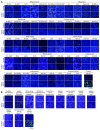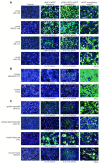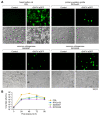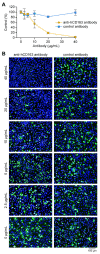Development and Characterization of a cDNA-Launch Recombinant Simian Hemorrhagic Fever Virus Expressing Enhanced Green Fluorescent Protein: ORF 2b' Is Not Required for In Vitro Virus Replication
- PMID: 33917085
- PMCID: PMC8067702
- DOI: 10.3390/v13040632
Development and Characterization of a cDNA-Launch Recombinant Simian Hemorrhagic Fever Virus Expressing Enhanced Green Fluorescent Protein: ORF 2b' Is Not Required for In Vitro Virus Replication
Abstract
Simian hemorrhagic fever virus (SHFV) causes acute, lethal disease in macaques. We developed a single-plasmid cDNA-launch infectious clone of SHFV (rSHFV) and modified the clone to rescue an enhanced green fluorescent protein-expressing rSHFV-eGFP that can be used for rapid and quantitative detection of infection. SHFV has a narrow cell tropism in vitro, with only the grivet MA-104 cell line and a few other grivet cell lines being susceptible to virion entry and permissive to infection. Using rSHFV-eGFP, we demonstrate that one cricetid rodent cell line and three ape cell lines also fully support SHFV replication, whereas 55 human cell lines, 11 bat cell lines, and three rodent cells do not. Interestingly, some human and other mammalian cell lines apparently resistant to SHFV infection are permissive after transfection with the rSHFV-eGFP cDNA-launch plasmid. To further demonstrate the investigative potential of the infectious clone system, we introduced stop codons into eight viral open reading frames (ORFs). This approach suggested that at least one ORF, ORF 2b', is dispensable for SHFV in vitro replication. Our proof-of-principle experiments indicated that rSHFV-eGFP is a useful tool for illuminating the understudied molecular biology of SHFV.
Keywords: Arteriviridae; Nidovirales; SHFV; Simarterivirinae; cell tropism; infectious clone; reverse genetics; simarterivirin; simarterivirus; simian hemorrhagic fever virus.
Conflict of interest statement
The authors declare no conflict of interest.
Figures










Similar articles
-
Each of the eight simian hemorrhagic fever virus minor structural proteins is functionally important.Virology. 2014 Aug;462-463:351-62. doi: 10.1016/j.virol.2014.06.001. Epub 2014 Jul 16. Virology. 2014. PMID: 25036340 Free PMC article.
-
Identification of the leader-body junctions for the viral subgenomic mRNAs and organization of the simian hemorrhagic fever virus genome: evidence for gene duplication during arterivirus evolution.J Virol. 1998 Jan;72(1):862-7. doi: 10.1128/JVI.72.1.862-867.1998. J Virol. 1998. PMID: 9420301 Free PMC article.
-
Simian hemorrhagic fever virus: Recent advances.Virus Res. 2015 Apr 16;202:112-9. doi: 10.1016/j.virusres.2014.11.024. Epub 2014 Nov 29. Virus Res. 2015. PMID: 25455336 Free PMC article. Review.
-
Within-Host Evolution of Simian Arteriviruses in Crab-Eating Macaques.J Virol. 2017 Jan 31;91(4):e02231-16. doi: 10.1128/JVI.02231-16. Print 2017 Feb 15. J Virol. 2017. PMID: 27974564 Free PMC article.
-
Molecular characterization of Lelystad virus.Vet Microbiol. 1997 Apr;55(1-4):197-202. doi: 10.1016/s0378-1135(96)01335-1. Vet Microbiol. 1997. PMID: 9220614 Free PMC article. Review.
Cited by
-
Duplex One-Step RT-qPCR Assays for Simultaneous Detection of Genomic and Subgenomic RNAs of SARS-CoV-2 Variants.Viruses. 2022 May 17;14(5):1066. doi: 10.3390/v14051066. Viruses. 2022. PMID: 35632807 Free PMC article.
-
Quantification of virus-infected cells using RNA FISH-Flow.STAR Protoc. 2023 May 18;4(2):102291. doi: 10.1016/j.xpro.2023.102291. Online ahead of print. STAR Protoc. 2023. PMID: 37209094 Free PMC article.
-
Primate hemorrhagic fever-causing arteriviruses are poised for spillover to humans.Cell. 2022 Oct 13;185(21):3980-3991.e18. doi: 10.1016/j.cell.2022.09.022. Epub 2022 Sep 30. Cell. 2022. PMID: 36182704 Free PMC article.
-
Isolation of Diverse Simian Arteriviruses Causing Hemorrhagic Disease.Emerg Infect Dis. 2024 Apr;30(4):721-731. doi: 10.3201/eid3004.231457. Emerg Infect Dis. 2024. PMID: 38526136 Free PMC article.
-
CD81 is a receptor for equine arteritis virus (family: Arteriviridae).mBio. 2025 Jul 9;16(7):e0062325. doi: 10.1128/mbio.00623-25. Epub 2025 May 27. mBio. 2025. PMID: 40422661 Free PMC article.
References
-
- Шевцoва З.В., Куксoва М.И., Джикидзе Э.К., Крылoва Р.И., Данькo Л.В. Экспериментальнoе изучение гемoррагическoй лихoрадки oбезьян. In: Lapin B.A., editor. Biology and Pathology of Monkeys, Studies of Human Diseases in Experiments on Monkeys. Materials of Symposium in Sukhumi, 17–22 October 1966. Academy of Medical Sciences of the U.S.S.R., Institute of Experimental Pathology and Therapy; Tbilisi, Georgian Soviet Socialist Republic, USSR: 1966. pp. 146–150.
-
- Шевцoва З.В. Изучение этиoлoгии гемoррагическoй лихoрадки oбезьян. Вoпр. Вирусoл. 1967;12:47–51. - PubMed
-
- Lauck M., Alkhovsky S.V., Bào Y., Bailey A.L., Shevtsova Z.V., Shchetinin A.M., Vishnevskaya T.V., Lackemeyer M.G., Postnikova E., Mazur S., et al. Historical outbreaks of simian hemorrhagic fever in captive macaques were caused by distinct arteriviruses. J. Virol. 2015;89:8082–8087. doi: 10.1128/JVI.01046-15. - DOI - PMC - PubMed
Publication types
MeSH terms
Substances
LinkOut - more resources
Full Text Sources
Other Literature Sources
Research Materials
Miscellaneous

